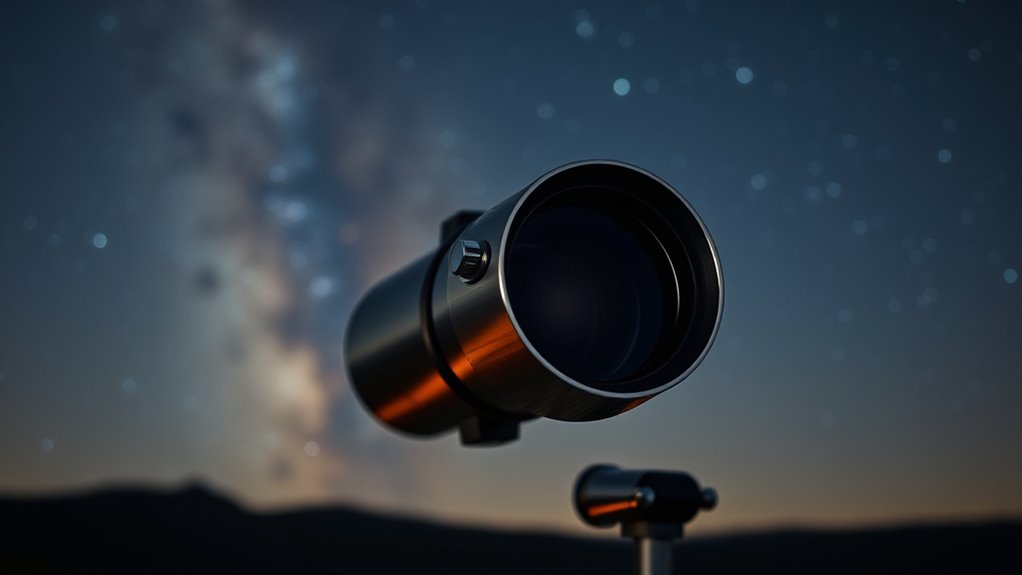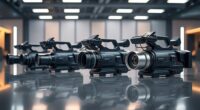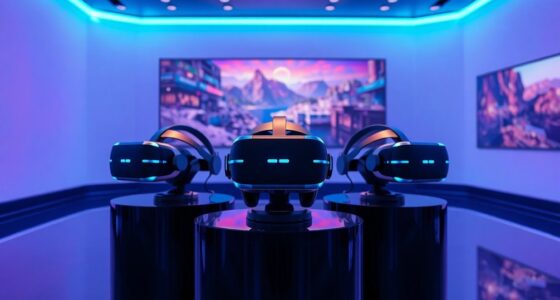If you’re looking for the best 130mm triplet APO refractors for astrophotography, I’ve found excellent options like the Explore Scientific ED102, FCD100 series, and Askar 120APO, which boast top-quality ED glass, high contrast, and sharp images. Portability and compatible accessories are key, too. If you’d like specific details about each model’s features and how they’re suited for stellar imaging, keep exploring—I’ll guide you through everything you need to know.
Key Takeaways
- 130mm triplet APO refractors offer high contrast, minimal chromatic aberration, and sharp images ideal for astrophotography.
- Consider optical quality, glass type, and coatings for optimal planetary and deep-sky imaging results.
- Portability and mount compatibility are crucial for field astrophotography setups and ease of use.
- Accessories like field flatteners, auto-guiders, and extension tubes enhance image quality and expand imaging capabilities.
- Customer support and warranty services impact long-term satisfaction and accessory compatibility for these advanced refractors.
SVBONY SV550 Triplet APO Telescope (122mm F7 ED Refractor)
If you’re looking for a portable and high-performance APO refractor that delivers sharp, color-free images, the SVBONY SV550 Triplet APO Telescope is an excellent choice. Its 122mm aperture and F7 focal ratio enable detailed astrophotography and observation, with a lightweight design weighing around 12 pounds. The high-quality FPL-51 triplet lens minimizes chromatic aberration, providing crisp, high-contrast images of planets, nebulae, and deep-sky objects. The dual-speed 2.5-inch focuser allows precise focusing, while the included carrying case makes it travel-friendly. Overall, this scope offers exceptional optical quality and portability at a competitive price, perfect for amateur astronomers and astrophotographers alike.
Best For: amateur astronomers and astrophotographers seeking a portable, high-quality APO refractor for detailed planetary and deep-sky imaging.
Pros:
- Excellent optical quality with sharp, color-free images and minimal aberrations
- Lightweight and portable design, ideal for travel and field use
- Dual-speed 2.5-inch focuser provides precise focusing for astrophotography
Cons:
- Slight dirt or dust between lens elements may require cleaning or maintenance
- Support and accessory compatibility issues reported by some users
- Moderate weight (~12 pounds) may require a sturdy mount for optimal stability
Explore Scientific ED102 Apochromatic Refractor Telescope
Looking for a high-performance refractor that delivers stunning astrophotography results with minimal chromatic aberration? The Explore Scientific ED102 Essential Series fits the bill perfectly. It features genuine FCD1 HOYA ED glass and multi-layer coatings on all optical surfaces, producing high-contrast, detailed images. Its air-spaced triplet design virtually eliminates chromatic aberration, ideal for capturing the Moon, planets, nebulae, and star clusters. With a 102mm aperture and f/7 focal ratio, it provides sharp, vibrant images at a 714mm focal length. Its portable build, retractable dew shield, and precision collimation system make it easy to set up and use in the field.
Best For: amateur and experienced astronomers seeking high-contrast astrophotography with minimal chromatic aberration in a portable, easy-to-use refractor.
Pros:
- Features genuine FCD1 HOYA ED glass and multi-layer coatings for superior image clarity and contrast
- Air-spaced triplet design effectively eliminates chromatic aberration, ideal for detailed astrophotography
- Compact, portable build with retractable dew shield and precision collimation system for easy setup in the field
Cons:
- May be higher in price compared to entry-level refractors
- Requires additional accessories (mount, camera adapters) for astrophotography setup
- Limited aperture size for deep-sky imaging of very faint objects without additional equipment
Explore Scientific ED80 Triplet Refractor Telescope for Astrophotography
The Explore Scientific ED80 Triplet Refractor Telescope stands out as an excellent choice for astrophotographers seeking high-quality, portable optics. Its 80mm aperture, f/6 focal ratio, and air-spaced triplet design deliver sharp, high-contrast images with minimal chromatic aberration, making it perfect for capturing the Moon, planets, nebulae, and star clusters. Built with genuine FCD1 HOYA ED glass and multi-layer coatings, it offers superior color correction and clarity. Its lightweight, compact size (around 6 pounds) and retractable dew shield make it highly portable, ideal for spontaneous observing sessions or guiding setups. While some mounting tweaks may be needed, it’s a versatile, reliable tool for stellar imaging.
Best For: amateur astrophotographers seeking a high-quality, portable apochromatic refractor for capturing detailed images of celestial objects.
Pros:
- Excellent optical quality with high-contrast, sharp images thanks to genuine FCD1 HOYA ED glass and multi-layer coatings
- Compact and lightweight design (around 6 pounds), making it highly portable and easy to transport
- Virtually eliminates chromatic aberration, ideal for astrophotography of Moon, planets, nebulae, and star clusters
Cons:
- Mounting solutions may require customization or additional accessories due to proprietary finder scope mounts and potential slipping of the mounting foot
- Some users report violet fringing on stars, though minimal compared to lesser optics
- The scope’s back focus may necessitate extension tubes or adapters for certain astrophotography setups
Explore Scientific FCD100 Series 80mm Air-Spaced Apochromatic Triplet Refractor Telescope
Designed for astrophotographers seeking high-quality imaging in a compact package, the Explore Scientific FCD100 Series 80mm Air-Spaced Apochromatic Triplet Refractor Telescope delivers exceptional optical performance. It features genuine Hoya FCD100 ED glass and multi-layer coatings, ensuring sharp, high-contrast images with minimal chromatic aberration. With an 80mm aperture, 480mm focal length, and f/6 ratio, it gathers ample light for capturing the Moon, planets, nebulae, and galaxies. Its lightweight, portable design, combined with a high-quality focuser and integrated dew shield, makes it ideal for on-the-go astrophotography. Explore Scientific’s solid support and reliable build earn this scope high praise among dedicated stargazers.
Best For: amateur astronomers and astrophotographers seeking a portable, high-performance refractor for capturing detailed images of celestial objects.
Pros:
- Exceptional optical quality with genuine Hoya FCD100 ED glass and multi-layer coatings for high contrast and minimal chromatic aberration
- Compact and lightweight design ideal for on-the-go astrophotography and spontaneous stargazing
- Includes premium features like a high-precision two-speed focuser, dew shield, and Vixen-style dovetail for versatile setup and ease of use
Cons:
- Slightly higher price point compared to entry-level refractors
- Limited aperture size may restrict deep-sky object viewing for advanced users
- Requires careful handling and proper mounting to maximize optical performance
Celestron StarSense Explorer DX 130AZ Telescope with Smartphone Dock
If you’re just starting out in astrophotography and want an easy-to-use telescope that simplifies target finding, the Celestron StarSense Explorer DX 130AZ with Smartphone Dock is an excellent choice. Its 130mm Newtonian reflector delivers bright, detailed views of the Moon, planets, and deep-sky objects like Orion and Andromeda. The built-in StarSense technology uses sky recognition to identify your position, and the app guides you to targets with on-screen arrows. The manual altazimuth mount with slow-motion controls makes tracking straightforward, and setup is simple. With Celestron’s reputation and a 2-year warranty, this telescope is perfect for beginners seeking quick, reliable access to the cosmos.
Best For: beginners and amateur astronomers seeking an easy-to-use, smartphone-integrated telescope for celestial observation and basic astrophotography.
Pros:
- User-friendly setup with automated sky recognition technology for quick target acquisition
- Bright, detailed views of the Moon, planets, and deep-sky objects thanks to the 130mm aperture
- Manual altazimuth mount with slow-motion controls makes tracking objects straightforward
Cons:
- Limited tracking capabilities compared to motorized mounts for long-exposure astrophotography
- Smartphone docking and app reliance may require compatibility checks and updates
- Designed primarily for visual observing rather than advanced astrophotography or planetary imaging
Explore Scientific FCD100 Series ED102 Refractor Telescope (OTA Only)
For astrophotographers seeking exceptional optical performance in a lightweight package, the Explore Scientific FCD100 Series ED102 refractor stands out. This 102mm f/7 apochromatic triplet features genuine HOYA FCD100 ED glass and proprietary EMD multi-layer coatings, ensuring sharp, high-contrast images with minimal chromatic aberration. Weighing just 10.9 lbs, its air-spaced aluminum tube offers durability and ease of handling. With a 714mm focal length and 1.14 arcsecond resolution, it’s perfect for detailed astrophotography. Designed for high-precision observation, this OTA combines superb optics with portability, making it a versatile choice for capturing stunning celestial images.
Best For: astrophotographers and amateur astronomers seeking lightweight, high-precision optical performance for detailed celestial imaging.
Pros:
- Exceptional optical clarity with genuine HOYA FCD100 ED glass and advanced coatings
- Lightweight yet durable aluminum tube for easy handling and portability
- High resolution of 1.14 arcseconds ideal for detailed astrophotography
Cons:
- OTA only, requiring additional mounting and accessories for complete setup
- 10.9 lbs weight may still be somewhat heavy for ultra-portable configurations
- Focal length of 714mm might limit wide-field imaging options without additional accessories
SVBONY SV105 Telescope Camera for Astrophotography
Looking for an easy-to-use astrophotography camera that delivers sharp lunar and planetary images without breaking the bank? The SVBONY SV105 is a 1/2.8 IMX307 CMOS color camera designed for beginners. It features a standard 1.25-inch threaded interface compatible with most telescopes and filters. Capable of real-time viewing, video recording, and live streaming at 1920×1080 resolution, it captures high-quality 2K videos at 30 fps. Its small sensor, combined with dark light compensation, produces clear images even in low-light conditions. Weighing just under a pound, it’s perfect for planetary imaging and easy to set up with software like SharpCap or AstroDMx Capture.
Best For: beginner astrophotographers seeking an affordable, easy-to-use camera for planetary and lunar imaging with quick setup and decent image quality.
Pros:
- User-friendly plug-and-play setup compatible with Windows, Linux, and Android devices
- High-resolution 1080p video recording at 30 fps for detailed planetary and lunar images
- Compact and lightweight design making it portable and easy to mount on various telescopes
Cons:
- Limited resolution compared to higher-end astrophotography cameras
- Occasional hardware recognition issues and overheating reports from some users
- Requires stable tracking for optimal planetary imaging due to small sensor size
Celestron Omni XLT 120 Refractor Telescope
The Celestron Omni XLT 120 Refractor Telescope stands out as an excellent choice for amateur astronomers seeking high-quality imaging and reliable tracking. Its hand-selected optical tube with premium glass and fully multi-coated StarBright XLT coatings maximizes light transmission, delivering brighter, sharper images. The ultra-precise CG-4 German equatorial mount, with worm gear slow-motion controls and ball bearings, guarantees smooth, accurate tracking. Included accessories like a finderscope, sturdy tripod, and eyepiece make setup straightforward. Plus, the free Starry Night software helps you explore over 36,000 celestial objects, making this scope a versatile tool for both beginners and experienced stargazers.
Best For: amateur astronomers and stargazing enthusiasts seeking high-quality optics, precise tracking, and educational resources for both beginner and intermediate sky observation.
Pros:
- High-quality, fully multi-coated StarBright XLT optics for brighter, clearer images
- Ultra-precise CG-4 German equatorial mount with smooth tracking and stability
- Comes with essential accessories and free Starry Night software for learning and exploration
Cons:
- Heavier and bulkier due to sturdy tripod and mount, less portable for travel
- Requires some setup time, especially for beginners unfamiliar with equatorial mounts
- Limited to optical viewing, with no included astrophotography features
SVBONY SV550 Telescope with Accessories
If you’re seeking a portable yet capable astrophotography telescope, the SVBONY SV550 stands out with its high-quality 80mm F6 APO triplet design. It features advanced optics with internal light barriers for minimal interference and a magnesium alloy focusing seat that’s 20% lighter for easy handling. The bundle includes a field flattener supporting full-frame cameras, plus adapters and extension tubes for precise back focus. Weighing just 8.8 pounds and measuring under 15 inches, it’s ideal for travel. Its sharp, flattened images across the field, combined with solid build quality and simple setup, make it an excellent choice for deep sky imaging on a budget.
Best For: amateur astrophotographers seeking a portable, high-quality telescope capable of capturing deep sky objects with sharp, flat-field images on a budget.
Pros:
- Compact and lightweight design (8.8 pounds, under 15 inches), ideal for travel and field use.
- High-quality 80mm F6 APO triplet optics with internal light barriers for minimal image interference.
- Includes a full-frame supporting field flattener, adapters, and extension tubes for versatile setups.
Cons:
- Low-profile mount/rail may limit clearance when balancing heavier accessories.
- Sensitive focus locks require careful handling to avoid unintentional shifts.
- Internal dust may be present but is easily cleaned during disassembly.
Askar 120APO Telescope for Astrophotography and Viewing
For astrophotographers seeking a portable yet high-performance telescope, the Askar 120APO stands out thanks to its compact 120mm aperture and F7 focal ratio. Its triplet air-spaced APO design, with one ED glass element, guarantees sharp, high-contrast images perfect for astrophotography and viewing. Weighing just 5.7kg and measuring 722mm with the dew shield retracted, it’s easy to transport and set up. The package includes a handle, tube rings, and a Vixen dovetail plate, making mounting straightforward. Its optical quality and thoughtful design make it an excellent choice for both amateur and advanced astronomers seeking stellar images in a portable package.
Best For: astrophotographers and amateur astronomers seeking a portable, high-quality telescope for both astrophotography and celestial viewing.
Pros:
- Compact and lightweight design (5.7kg, 722mm length) for easy transport and setup
- High-quality triplet air-spaced APO optics with ED glass for sharp, high-contrast images
- Includes essential accessories like handle, tube rings, and Vixen dovetail for straightforward mounting
Cons:
- Limited to a 120mm aperture, which may limit deep-sky object brightness compared to larger telescopes
- Slightly higher price point due to premium optical design and accessories
- Requires careful handling and proper mounting to maximize optical performance
Explore Scientific FCD100 127mm f/7.5 Carbon Fiber Triplet ED APO Refractor Telescope
Designed for serious astrophotographers, the Explore Scientific FCD100 127mm f/7.5 Carbon Fiber Triplet ED APO Refractor offers exceptional optical quality with its advanced ED glass elements and lightweight carbon fiber construction. Its 127mm aperture and 952mm focal length deliver sharp, high-contrast images, with a resolution of 0.9 arcseconds. The 2.5 HEX focuser provides smooth adjustments, though some users find the included accessories lacking. Weighing just 14 pounds, it’s portable but priced higher than comparable models. While it produces impressive views, customer support and accessory quality have received mixed reviews, so manage expectations accordingly.
Best For: serious astrophotographers seeking high-quality optical performance and advanced design in a lightweight, portable refractor telescope.
Pros:
- Exceptional optical quality with advanced ED glass elements for sharp, high-contrast images
- Lightweight carbon fiber construction makes it highly portable at only 14 pounds
- Smooth 2.5 HEX focuser allows precise adjustments for detailed imaging
Cons:
- Accessories such as the included diagonal and focuser may not meet expectations and can impact overall experience
- Customer support and warranty service are often reported as unresponsive and unhelpful
- Higher price point compared to similar models with comparable optical performance
Factors to Consider When Choosing 130MM Triplet APO Refractors for Astrophotography

When selecting a 130mm triplet APO refractor for astrophotography, I consider several key factors to guarantee the best experience. From optical quality and focal length to mount compatibility and portability, each aspect impacts the final results and ease of use. Let’s explore these points to help you make an informed choice.
Optical Quality and Glass
Optical quality and the glass used in a 130mm triplet APO refractor are critical factors that directly influence image sharpness, color accuracy, and overall performance in astrophotography. High-quality scopes employ ED (extra-low dispersion) glasses like FPL-51, FCD1, or FCD100, which substantially reduce chromatic aberration and improve color correction. The air-spaced triplet design with three optical elements ensures superior correction of spherical and chromatic aberrations, resulting in sharper, high-contrast images. Multi-layer coatings on all optical surfaces enhance light transmission, minimize reflections, and boost brightness and contrast. Precise fabrication and polishing are essential for diffraction-limited performance, maintaining pinpoint stars across the entire field. The choice of glass and design impacts the scope’s ability to produce crisp, color-accurate images, essential for high-resolution astrophotography.
Focal Length and Ratio
Focal length and ratio are key factors to contemplate because they directly affect the scope’s imaging capabilities and suitability for different astrophotography targets. A longer focal length offers higher magnification, revealing more planetary surface details, but narrows the field of view, making wide-field imaging more challenging. Typically, a 130mm triplet with an f/7 ratio around 840mm strikes a good balance, providing enough detail for planets and still accommodating wide-field objects. Faster ratios, like f/6 or lower, produce wider fields perfect for deep-sky objects, but they demand more precise tracking and better mounts. Ultimately, the focal length and ratio shape what targets your scope excels at, whether planetary detail or expansive nebulae.
Mount Compatibility and Weight
Choosing the right mount for your 130mm triplet APO refractor is vital because it directly impacts your astrophotography success. Ensure the mount’s payload capacity exceeds the telescope and accessories’ combined weight by 15-20% to maintain stability and smooth tracking. Since a typical 130mm triplet weighs around 10 to 15 pounds, pick a mount that comfortably supports this load. Check that the mount’s dovetail interface matches your telescope’s rail, such as Vixen or Losmandy style, for secure attachment. For astrophotography, opt for a mount with auto-guiding support and PEC features to improve tracking accuracy during long exposures. Remember, heavier mounts tend to be more stable but may require sturdier tripods and could affect portability for field use.
Field Flatness and Correctors
Ensuring excellent field flatness is essential for capturing sharp, focused images across the entire frame, especially when using a 130mm triplet APO refractor for astrophotography. Flatness prevents star elongation and edge aberrations that can compromise image quality. Many high-quality triplet APOs include built-in or optional field correctors, such as field flattener lenses, to achieve a flat focal plane suitable for large or full-frame sensors. The effectiveness of these correctors depends on precise back focus distance and proper spacing, which varies among models and can impact image sharpness. Poor flatness leads to vignetting and reduced scientific value. Hence, choosing a refractor with reliable, adjustable field flatteners is vital for consistent, high-quality astrophotography results.
Portability and Setup Ease
When selecting a 130mm triplet APO refractor for astrophotography, portability and ease of setup are crucial considerations, especially if you plan to shoot in the field or travel frequently. A lightweight design, often under 15 pounds, makes transportation and assembly straightforward. Compact focal lengths, around 700-800mm, result in shorter tubes that are easier to handle and require smaller mounting setups. Features like integrated or quickly attachable dew shields and minimal external accessories allow for rapid deployment during spontaneous sessions. A smooth, precise focuser reduces setup time and improves focusing accuracy in the field. Additionally, compatibility with lightweight yet sturdy mounts ensures stability and quick setup, making these refractors highly practical for astrophotographers on the move.
Price and Value Ratio
Price and value play a significant role in selecting a 130mm triplet APO refractor for astrophotography. A higher price often indicates better optical quality, premium materials, and extra features, but it doesn’t always mean better value if the performance doesn’t meet expectations. When evaluating the price-to-value ratio, consider included accessories like field flatteners or mounting options, which can boost imaging without extra costs. Cheaper models might suit beginners with adequate optics but often lack advanced features such as high-quality ED glass or sturdy focusers, impacting long-term use for serious astrophotographers. Ultimately, a good balance depends on optical performance, build quality, and compatibility, not just price. Comparing user reviews and expert opinions helps determine if the investment provides genuine benefits for stellar imaging.
Support and Warranty Services
Reliable support and warranty services are essential when investing in a 130mm triplet APO refractor for astrophotography, as they guarantee any issues with optics, mechanics, or accessories are resolved promptly. A reputable manufacturer offers clear warranty policies, accessible technical assistance, and responsive customer service, ensuring peace of mind. It’s important to verify if the warranty covers both parts and labor, and to check its duration, which can range from one to several years. Good support also includes detailed manuals and troubleshooting guidance, making it easier to resolve common problems. According to consumer reviews, responsive after-sales service greatly impacts overall satisfaction. Ensuring reliable support and warranty coverage helps protect your investment and keeps your astrophotography sessions smooth and frustration-free.
Accessories and Expandability
Choosing a 130mm triplet APO refractor with expandability in mind means guaranteeing it supports a wide range of accessories that can enhance your astrophotography experience. Look for compatibility with field flatteners, auto-guiders, and extension tubes to boost imaging versatility. Verify that it offers standard mounting options like Vixen or Losmandy dovetails for easy attachment and flexibility. Consider the focus travel distance and whether it supports dual-focusers or auto-focus systems for precise focusing. Check if it includes or can easily adapt accessories like finderscopes, diagonals, and filters, which improve observational and imaging capabilities. Finally, ensure the scope allows for upgrades or customization, enabling you to swap proprietary parts with standard accessories, future-proofing your investment.
Frequently Asked Questions
How Does Aperture Size Impact Astrophotography Quality in 130MM Triplet APOS?
Aperture size directly impacts astrophotography quality because larger apertures gather more light, revealing fainter details and improving image clarity. With a 130mm triplet APO, I notice brighter, sharper images and better contrast, especially for deep-sky objects. It also helps reduce noise and increases resolution. So, a bigger aperture means better data, more detail, and stunning astrophotos, making the investment worthwhile for serious stargazing.
What Maintenance Is Required for Air-Spaced Triplet Refractors?
Think of your air-spaced triplet refractor as a delicate garden needing care. I regularly check for dust and clean the lenses with a gentle blower or brush, avoiding harsh chemicals. I also make certain the lens cells are secure and protected from humidity. Periodic collimation keeps the optics aligned, just like pruning to keep plants healthy. Proper maintenance preserves image clarity and extends the life of your precious instrument.
Are There Specific Filters Recommended for 130MM Triplet APO Astrophotography?
For 130mm triplet APO astrophotography, I recommend using narrowband filters like H-alpha, OIII, and SII to capture specific emission lines and enhance details. A light pollution filter can also help in urban areas. I personally prefer high-quality, multi-band filters from brands like Astronomik or Baader, as they provide sharp, contrast-rich images. These filters make a significant difference in revealing deep-sky objects with clarity and color accuracy.
How Do Different Mounting Options Affect Imaging Stability?
Different mounting options profoundly impact imaging stability. For example, I once used a lightweight mount for a quick session, and my images showed noticeable star trails. Upgrading to a sturdy equatorial mount with a solid tripod reduced vibration and improved focus. A stable mount minimizes movement, ensuring sharper images and longer exposures. So, investing in a robust mount is essential for clear, detailed astrophotography results.
Can These Telescopes Be Used Effectively for Planetary Versus Deep-Sky Imaging?
Absolutely, these telescopes excel at both planetary and deep-sky imaging. Their high contrast and sharp optics make planetary details pop, while their apochromatic design reduces chromatic aberration for stunning deep-sky shots. I’ve found that with the right mount and accessories, they’re versatile tools that deliver excellent results across different astrophotography targets. Whether I’m capturing Jupiter’s storms or distant nebulae, these refractors perform impressively.
Conclusion
Choosing the right 130mm triplet APO refractor truly feels like a stroke of luck—each one offers unique benefits that can elevate your astrophotography. Whether it’s the precision of the Explore Scientific models or the versatility of the SVBONY options, finding the perfect match often comes down to timing and your specific needs. Ultimately, the best scope is the one that aligns with your passion and enhances your journey among the stars.






















